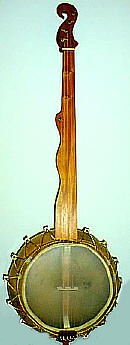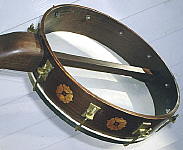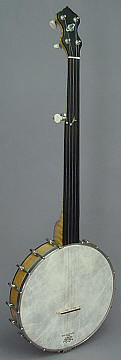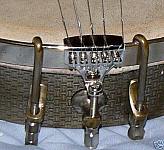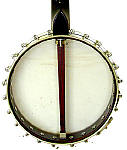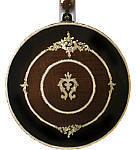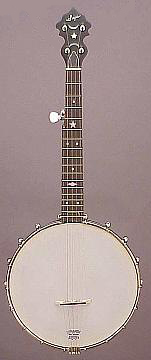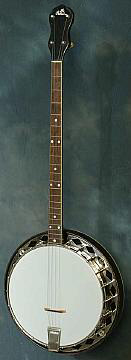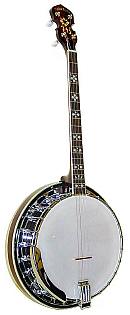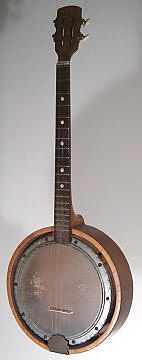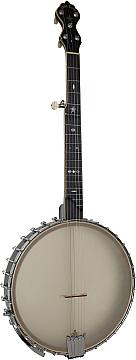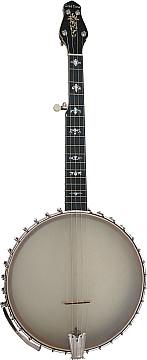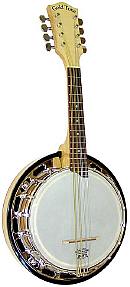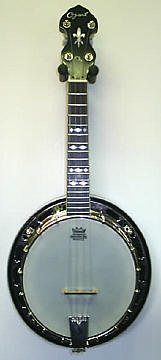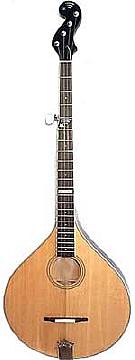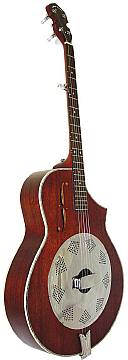| banjos | ATLAS of Plucked Instruments |
| •
HOME • about • collection • books • index • links • lutes • guitars early • guitars modern • mandolins • cittern • banjos • steelguitars • miscellaneous • Europe West • Europe East • Europe South • Africa • Middle East • Central Asia • India • Far East • S.E. Asia • America N • America C • America S
|
banjos To most people all banjos look
(and sound) the same. However there were and are many different types,
most of which can be found on this page.
|
|
gourd banjo Although the early history of the banjo is not
really clear, most people believe the origin lies in instruments from
Africa (see ngoni and akonting on the page Africa).
Names used in early manuscripts were banjar, bonja, banza, strum-strum, etc. The body was made of hollowed-out wood, but much easier was the use of gourds, with a piece of animal skin streched over the open front and (as good glue was difficult to get) made tight with ropes around it or with tacks around the edge. The early instruments did not have frets, and probably had only 3 or 4 strings, but often already with the short string from a peg halfway the neck.
|
|||||||||
| top | ||||||||||
|
minstrel banjo After around 1830, the banjo instrument was taken over from the "blacks" by the "whites". White performers (with a blackface to caricature the black culture) danced and sang simple jolly songs, accompanied on a kind of banjo. These Minstrel Shows became quite popular and slowly the instruments were made of a better quality. As these instruments were all made by local craftsman, there is quite some difference in shape between instruments. The flat tuninghead (with pegs from behind) sometimes had a sideways curl. Eventually the stringing with 4 gut strings and one from a peg halfway the neck, became the norm. Tuning would often be an open G-chord : g' d g b d'.
Playing style was with fingerpicking, frailing or strumming. See for more information and pictures (and sound) Minstrelbanjo. |
|||||||||
| top | ||||||||||
|
fretless banjo Eventually, after 1850, the minstel banjo developed slowly into a main 5-string banjo. First still without frets (like the example), but soon frets and better bodies were made. This banjo was used for Old-Time Style and
for Mountain Music. Note however that most of this music is also played
on a fretted 5-string banjo. Playing is often in "frailing" style, by which the fingers do not pluck upwards, but hit the strings going downwards. Even the thumb moves different. Because of the funny shape of your right hand this playing style is also called "clawhammer banjo".
|
|||||||||
| top | ||||||||||
Open back and resonator This resonator has no connection with the resonator guitars (see steelguitars), but is a round wooden "lid" that can be fixed to the back of the banjo body, and is meant to project the sound forwards. It also makes the back feel more comfortable against the stomach, instead of all the hooks and nuts...
Banjos have always been instruments that recieved lots of decoration, with inlayed fingerboards, carved necks, pegheads and especially (though not visible while playing) the resonator.
The fingerboard is always flush with the top of the head (the skin) and stops at the rim of the body. Note also that the (loose) bridge is placed at the lower half of the head (so not in the centre). |
||||||||||
| top | ||||||||||
|
5-string banjo In the late 1900 untill about 1940 the banjo
was quite popular and in the beginning many inventions were used to
improve the instrument. Like the development of a heavy metal tone-ring,
a proper fingerboard with about 22 guitar-like metal frets, steel strings,
an armrest on the side, and a resonator on the back. Tuning of the (now usually) metal strings is still : g' d g b d'. The playing technique changed from strumming to fingerpicking.
After the 1940s banjos were mainly only used for bluegrass, traditional jazz, folk and Irish music.
|
|||||||||
| top | ||||||||||
|
banjourine When around 1900 special banjo-orchestras were formed
(like the mandolin orchestras) there was a need for different
size instruments. All these instruments had 5 strings and were tuned
in a similar relative tuning. The banjourine was a 5-string banjo with a short
scale, with 5 frets shorter (17 frets on the neck). Other spellings
were banjorine and banjeaurine. Playing was often with fingers, or with a plectrum for melody lines, like on a mandolin.
|
|||||||||
| top | ||||||||||
|
plectrum banjo The plectrum banjo developed in the 1920s, when players who played (with a plectrum) in a jazz- or Dixieland band, dismissed with the short 5th string. The plectrum banjo is the same size as a 5-string banjo, so usually 22 frets. The tuning is like a 5-string banjo, but without the short 5th string : d g b d'. It is in general played (of course) with a plectrum, in melody style with chords in between. For more information and pictures of 4-string banjo's see Riverboatmusic.
|
|||||||||
| top | ||||||||||
|
tenor banjo The tenor banjo has a remarkable name : it is not really the "tenor" of the family of banjos (there are no soprano or alto banjos....). The tenor banjo developed in the 1910s from
the 4-string plectrum banjo, by shortening the neck. The tenor banjo has 17-19 frets on the neck, and is played with a plectrum, often strumming chords, in jazz- and Dixieland orchestras. After 1930s the guitar suddenly became more popular and players of the tenor banjo in Jazz orchestras felt obliged to change to the guitar, but at first prefered to keep their tenor banjo tuning. So they used a 4-string guitar, which they tuned like a tenor banjo and which they therefore called the tenor guitar (see guitars2).
For more information and pictures of 4-string banjo's see Riverboatmusic. |
|||||||||
| top | ||||||||||
|
Irish banjo In Celtic music they use a tenor banjo, but
often these instruments look less flashy and are a bit smaller (and
a shorter scale length). However it is not really a separate type of
banjo. The Irish banjo is played with a plectrum. Playing style
is like all Irish music : to accompany other instruments with melody
lines, and the occasional solo. During solos often a very fast ornamental
triple is used. For more information about the Irish banjo : Deeringbanjos.
|
|||||||||
| top | ||||||||||
|
bluegrass banjo The 5-string banjo fell almost in complete disuse around 1950, except in Bluegrass music. After 1960 the banjo became slowly a bit popular again, both in folk music (mainly the open back type) and in Bluegrass (mainly the resonator type). The bluegrass banjo is a 5-string banjo, with a heavy metal tone-ring, and a fretted neck (with about 22 frets), often with geared tuners from the back. The head is now almost always made of plastic, rarely of real skin. Tuning of the 5 steel strings is still the open G-chord : g' d g b d'. The playing technique changed from strumming to fingerpicking with at least a thumb pick, but often special fingerpicks on 2 or 3 fingers as well. This lead eventually to the special complex 3-finger style developed by Earl Scruggs in the 1960s (Scruggs style). A special feature used on some bluegrass banjos are the Keith tuners : the tuners for the strings g and b are constructed in such a way that with one turn of the tuner the tuning of that string can be changed to another pre-fixed note.
|
|||||||||
| top | ||||||||||
|
longneck banjo In folk music players also still play the 5-string banjo, usually the type with the open back. It was folksinger/banjoist Pete Seeger in the 1960s, who needed sometimes to sing and play in a lower key than the normal G, and had this new type of instrument made for him so it was easier to play lower (by also re-tuning the 5th string). So the longneck banjo is just a normal 5-string banjo but with a longer neck: it has 3 frets extra, with the sidestring on the 8th fret. With a capo on the 3th fret it sounds the same as a normal 5-string banjo. It became quite popular with folk banjo players, really just only for the look of it, as they usually play it with a capo, as a normal 5-string banjo in G. For more information see Frets.com.
|
|||||||||
| top | ||||||||||
|
guitar banjo The guitar banjo is a hybrid instrument : a
combination of a banjo-body with a guitar-neck, with 6 guitar-strings.
Other names for it are banjitar and guitjo. The banjitar is tuned and played like a normal guitar (but sounds much louder !). Some exist even as a 12-string version, and some have a kind of guitar-body (with a hole for the round banjo-head !). For years this has been one of the most popular banjo for guitar players, as it makes the sound of the banjo, but can be played like a normal guitar.
|
|||||||||
| top | ||||||||||
|
6-string banjo For (real) banjo players who felt they needed
an extra (lower pitch) string, recently a 6-string banjo has
been developed (or beter : re-developed, as it also was used in the
early days of banjo orchestras). It is tuned : g' G d g b d', and is played like any other 5-string banjo (so frailing or Scruggs style).
|
|||||||||
| top | ||||||||||
|
cello banjo Another banjo type that recently has been re-introduced, after being used in the early days of banjo orchestras, is the cello banjo. It has a large (14'' = 350mm) body for a very loud voice.
The neck is slightly shorter than the normal bluegrass banjo.
It uses nylon strings (the four lower strings of a guitar).
The cello banjo can be played like any other banjo (so with a plectrum, or frailing or Scruggs style).
|
|||||||||
| top | ||||||||||
|
mandolin banjo A hybrid : a mandolin banjo has a banjo-body with a mandolin-neck, with 4 double strings. A banjolin is the same instrument, but with only 4 single strings. They were quite popular in the early 1900, in banjo orchestras (in the USA and UK), both for strumming as for picking with a plectrum. At that time there was quite a craze for (first) mandolin orchestras (with mandolin families) followed by banjo orchestras (with banjo families). It was easy to change over to the new type of instrument, with the same size/tuning. The mandolin banjo is tuned and played like a normal mandolin (but it sounds much louder !). See for more detailed information Expert.
|
|||||||||
| top | ||||||||||
|
ukulele banjo Another hybrid : a banjo-body with a ukulele-neck, with
4 nylon (or gut) strings. Another name is banjolele. This was the instrument used by the English comic singer George Formby, popular during the years 1930-1950.
|
|||||||||
| top | ||||||||||
|
zither-banjo The zither-banjo is in fact a kind of 5-string
banjo, but instead of the short 5th string on a peg on the side
of the neck, here this string goes over the 5th fret, and than through
a long hole (tube) to the top of the neck, where it is tuned like all
the other strings from a normal tuning machine (if normal 6 guitar-tuners
are used, one tuner is left empty). The zither-banjo was designed
in the 1890's.
Playing is with a plectrum, but with less force. For more information about many types of zither-banjos see zither-banjo. |
|||||||||
| top | ||||||||||
|
banjola Another hybrid instrument : a banjola, with the standard neck of a 5-string banjo and the body of a mandolin (or mandola). Although these instruments existed already for a short while in the 1900s, they have been re-introduced by Goldtone in the 1980s, who uses an old style tuninghead and a mandoline-type bridge. As you can imagine, the banjola has a very special sound, quite different from a banjo. See more information on banjolas.com. |
|||||||||
| top | ||||||||||
|
dojo A dojo is another banjo type which is quite a hybrid : a wooden guitar-body, with a biscuit type cone resonator and a 5-string banjo-neck. Only a few banjo-factories provide these dojo resophonic banjos (mix of DObro and banJO). The dojo is tuned and played like a normal bluegrass banjo, but sounds more like a guitar/dobro.
|
|||||||||
| top | ||||||||||
|
dulcijo A dulcijo is another banjo type which is quite a hybrid : a banjo type body, with a dulcimer neck. Developed by Michael Fox in the 1980's. The dulcijo has usually 3 strings (one halfway
the neck, like on a 5-string banjo).
|
|||||||||
|
